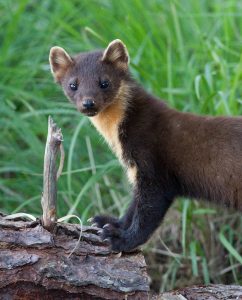 One of the mysteries of the animal world in the Highlands is over the very mixed fortunes of the closely related pine marten and polecat. For example in the last few decades the pine marten has increased its range southwards from the Highlands and increased its numbers. In direct contrast it is now believed that the polecat is extinct in the Highlands and has been for decades. One intriguing question is the reason for the extinction of the polecat. It fluctuated in numbers in the same way as the pine marten but there must have been one other factor that the pine marten could cope with but not the polecat. One reason, often mentioned, is that the polecat was more susceptible, for some unknown reason, to trapping with the gin traps and that was the last straw. Both the pine marten and polecat were very high on the persecution list as the lists from various estates show. One local estate, Invergarry, for example, shows that between 1837 and 1840 they killed 246 pine martens and 106 polecats. The list also includes 198 wildcats but, surprisingly only 11 foxes. These figures were typical of many Highland estates.
One of the mysteries of the animal world in the Highlands is over the very mixed fortunes of the closely related pine marten and polecat. For example in the last few decades the pine marten has increased its range southwards from the Highlands and increased its numbers. In direct contrast it is now believed that the polecat is extinct in the Highlands and has been for decades. One intriguing question is the reason for the extinction of the polecat. It fluctuated in numbers in the same way as the pine marten but there must have been one other factor that the pine marten could cope with but not the polecat. One reason, often mentioned, is that the polecat was more susceptible, for some unknown reason, to trapping with the gin traps and that was the last straw. Both the pine marten and polecat were very high on the persecution list as the lists from various estates show. One local estate, Invergarry, for example, shows that between 1837 and 1840 they killed 246 pine martens and 106 polecats. The list also includes 198 wildcats but, surprisingly only 11 foxes. These figures were typical of many Highland estates.
There are still a few reports of polecats and the “Atlas of Highland Land Mammals” 2011 gives a few records for Caithness. However, if these are true polecats they are more likely to be from re-introductions than native to the site. The latest valid records for the Highlands are for 1969. As for re-introductions, I can never understand why people go to so much trouble over such activities without formally registering what they have done to the various organisations. There is also the problem of mis-identification as ferrets can be mistaken as can polecat/ferrets often favoured because of their larger size. The situation over many islands is confusing as many ferrets are deliberately introduced to keep down the rabbit numbers because of the damage they do to crops.
As for the pine martens there are now more in Scotland, including the Highlands, than ever before and for conservationists and organisations it is a success story. The leading such authority is the Vincent Wildlife Trust who have pioneered the design and erection of pine marten den boxes. The occupation rate and breeding rate has been high including areas in southern Scotland. The Trust is now in the process of taking pine martens from the Highlands into Wales and the latest I hear is that the programme is going well with breeding already having taken place. There are plans for more pine martens being taken there as it has been so successful.
One interesting aspect of the pine marten concerns their inter-reaction with the red squirrel as many people just say that they prey on red squirrels. Fortunately there seems to be no proof that there is direct predation and I know of no record of a pine marten taking an adult live red squirrel. No doubt young – called kits – are taken but the adult red squirrels are more likely to be in the form an injured red squirrel, such as from a road casualty. There is much more evidence of pine marten predating grey squirrels. However, there is now the problems of pine martens taking over nest boxes designed for birds such as owls, goldeneye and mandarin ducks. Fortunately these can be modified. With the increase in pine martens there is also the problem of them attacking domestic hens and ducks and the answer is to make sure the birds are put away in a shed each night.
Tags: highland wildlife
